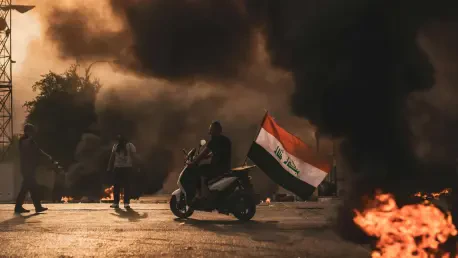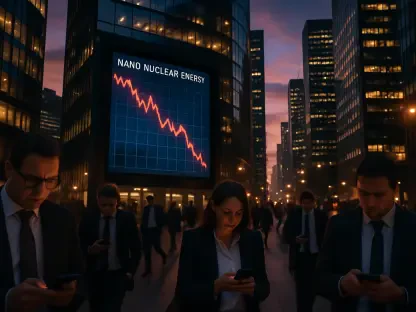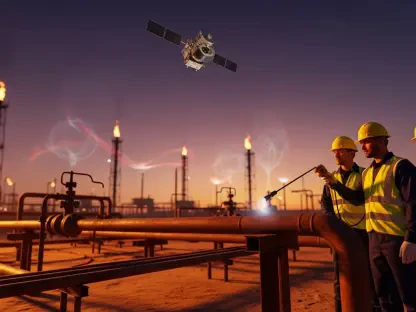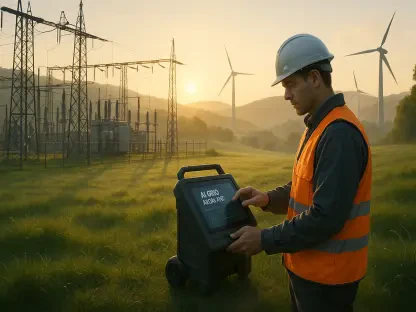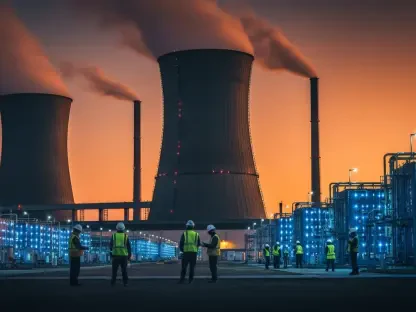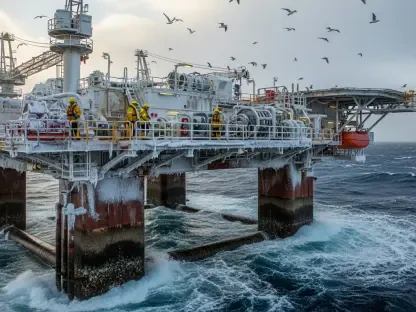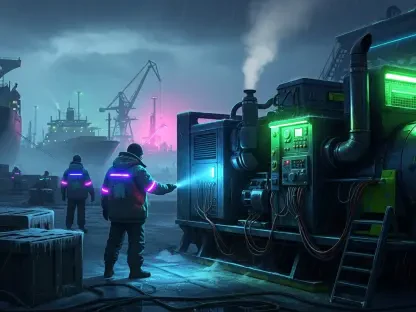In a nation rich with oil yet plagued by darkness, Iraq faces an energy crisis that leaves millions without reliable electricity, a struggle that has persisted for over two decades since the U.S.-led invasion in 2003. As OPEC’s second-largest oil producer, the country paradoxically burns off vast amounts of associated gas due to inadequate infrastructure, failing to convert this resource into power for its people. This systemic shortfall has driven Iraq into heavy reliance on imported gas, particularly from neighboring Iran, to keep its grid operational. The human toll is evident in stories like that of Hussain Saad, a Baghdad butcher whose livelihood suffers as meat spoils during frequent blackouts. A proposed gas swap deal with Turkmenistan, routed through Iran, emerged as a potential lifeline to diversify supply, but it stumbled on a critical hurdle: the inability to gain U.S. approval. This rejection underscores the intricate web of geopolitical pressures and energy needs that Iraq must navigate, setting the stage for a deeper exploration of the challenges at play.
Geopolitical Constraints on Iraq’s Energy Plans
U.S. Sanctions and Iran’s Role
The shadow of U.S. sanctions on Iran looms large over Iraq’s attempts to secure alternative gas supplies, acting as a formidable barrier to innovative energy deals like the Turkmen gas swap. Announced in 2023, this arrangement aimed to deliver approximately 5 billion cubic meters of gas annually from Turkmenistan to Iraq via Iran, with the latter taking a portion as compensation rather than direct payment to skirt sanctions. Despite Iraq’s proposal for third-party international monitoring to ensure compliance, the U.S. rejected the deal over concerns that it could indirectly benefit Iran. This decision reflects a broader American policy of curbing Tehran’s influence, even at the expense of Iraq’s pressing energy needs. The impact of such sanctions became starkly evident when waivers allowing Iraq to pay for Iranian power were terminated in March, resulting in a loss of around 3,000 megawatts of generation capacity during peak summer demand, a blow felt by millions of households across the country.
Beyond the immediate rejection of the Turkmen deal, the end of U.S. sanctions waivers has had a cascading effect on Iraq’s already fragile power grid, exacerbating an ongoing crisis. With Iran supplying nearly a third of Iraq’s power generation through gas imports, the loss of financial mechanisms to sustain these imports has directly translated into blackouts and reduced electricity access. The U.S. stance, driven by a “maximum pressure” approach toward Iran initiated during the Trump administration, prioritizes geopolitical strategy over Iraq’s stability, leaving Baghdad in a bind. Iraqi officials have expressed frustration over this rigidity, noting that the absence of viable alternatives forces them to bear the brunt of a policy aimed at another nation. This situation highlights how international sanctions, while targeting Iran, inadvertently deepen Iraq’s energy insecurity, pushing the country to seek solutions under increasingly constrained circumstances.
Balancing U.S. and Iranian Interests
Iraq finds itself trapped in a delicate diplomatic dance between two powerful allies, the U.S. and Iran, with its energy policy caught in the crossfire of their conflicting interests. Proceeding with the Turkmen gas deal without U.S. approval risks severe repercussions, including potential sanctions on Iraqi financial institutions, which could further destabilize an already strained economy. The fear of such punitive measures has kept the agreement in limbo, despite months of lobbying efforts to convince Washington of its necessity. This hesitation stems from the understanding that any misstep could jeopardize Iraq’s broader relationship with the U.S., a key partner in security and economic aid. Meanwhile, the stakes of maintaining cordial ties with both nations create a tightrope for Iraqi policymakers, who must weigh immediate energy needs against long-term geopolitical consequences in every decision they make.
The alternative to defying U.S. policy—losing access to Iranian gas—presents an equally dire scenario for Iraq, where power generation heavily depends on these imports. Accounting for a substantial portion of the country’s energy mix, Iranian gas is critical, especially during summer months when demand surges to as much as 45 million cubic meters per day. A complete cutoff, as nearly occurred after the waiver termination, could trigger a collapse of the national grid, plunging cities into darkness and stalling essential services. Iraqi officials have warned of catastrophic outcomes if this lifeline is severed, emphasizing that no immediate substitute exists to fill the gap. This precarious balance illustrates the immense pressure on Iraq to navigate its alliances carefully, as alienating either the U.S. or Iran could have devastating ripple effects on both energy security and national stability, leaving the population to endure the consequences of international rivalries.
Energy Crisis and Domestic Challenges
Persistent Power Shortages
Iraq’s struggle to provide consistent electricity to its citizens remains a deeply rooted issue, tracing back to the aftermath of the 2003 U.S.-led invasion that shattered much of the country’s infrastructure. Decades of underinvestment, coupled with conflict and mismanagement, have left the power sector in disarray, unable to meet the needs of a growing population. Despite vast oil wealth, the inability to harness associated gas—often flared off wastefully—means that blackouts are a daily reality for many. The human cost of this crisis is palpable in personal accounts like that of Hussain Saad, a butcher in Baghdad who watches his inventory spoil during frequent outages, unable to afford the high costs of private generators. Such stories reflect a broader frustration among Iraqis, for whom unreliable power is not just an inconvenience but a barrier to basic economic survival, fueling discontent across urban and rural communities alike.
This persistent energy deficit has far-reaching implications, driving social unrest and economic hardship throughout Iraq, where electricity is tied to nearly every aspect of daily life. Power shortages disrupt businesses, halt industrial production, and strain healthcare facilities, often leaving hospitals unable to operate critical equipment during outages. Public anger over these failures has spilled into the streets in the form of protests, with citizens demanding accountability from a government that struggles to deliver basic services despite the nation’s resource wealth. The summer months, when temperatures soar and demand peaks, exacerbate these tensions, as families endure long hours without cooling or lighting. This cycle of deprivation and dissatisfaction underscores the urgent need for systemic reform in Iraq’s energy sector, a challenge made more complex by external political pressures that limit the country’s options for addressing these domestic woes effectively.
Reliance on Imported Gas
Iraq’s heavy dependence on imported gas, particularly from Iran, has become a cornerstone of its energy strategy, yet it exposes the country to significant vulnerabilities. In recent figures, imports from Iran reached 9.5 billion cubic meters, fueling nearly a third of Iraq’s power generation and serving as a critical stopgap for a nation unable to fully utilize its own resources. This reliance stems from systemic failures in domestic infrastructure, where the lack of facilities to capture and process associated gas from oil fields results in massive waste through flaring. Such inefficiencies mean that even as OPEC’s second-largest oil producer, Iraq must look abroad to keep its lights on, a paradox that highlights the depth of its energy mismanagement. This dependency not only strains national finances but also ties Iraq’s energy security to the stability of its relationship with a sanctioned neighbor.
The seasonal fluctuations in Iraq’s gas demand further complicate this reliance, creating a volatile energy landscape that tests the limits of the current system. During the scorching summer months, consumption can spike to 45 million cubic meters per day, driven by the need for air conditioning and other cooling systems, while cooler months see demand drop to as low as 10-20 million cubic meters daily. This variability places immense pressure on supply chains, particularly when imports from Iran are disrupted by geopolitical events or payment issues tied to U.S. sanctions. The nationwide blackout in August, triggered by the loss of Iranian gas after waivers ended, serves as a grim reminder of how quickly the situation can deteriorate. Iraqi officials continue to grapple with these oscillations, aware that without a diversified energy portfolio, each peak season risks plunging the nation deeper into crisis, amplifying both economic losses and public frustration over persistent shortages.
Alternative Energy Strategies
Exploring New Import Options
In the aftermath of the failed Turkmen gas deal, Iraq has turned its attention to alternative import options, notably liquefied natural gas (LNG) from countries like Qatar and Oman, as a means to reduce reliance on Iranian supplies. Plans are underway to lease a floating LNG terminal, which would facilitate the import of this fuel to power plants, offering a temporary bridge to stabilize the grid. However, this solution comes with significant logistical challenges, including the need to construct or adapt port facilities and ensure a steady supply chain amid regional uncertainties. While LNG imports could provide a critical buffer, especially during peak demand periods, they are not without drawbacks, such as higher costs compared to pipeline gas and the environmental footprint of transportation. This shift represents a pragmatic, albeit complex, step for Iraq as it seeks to diversify its energy mix under the weight of geopolitical constraints that limit other avenues.
The transition to LNG imports also raises questions about long-term versus short-term benefits, as Iraq navigates the trade-offs of this expensive alternative against the backdrop of an immediate energy crisis. Setting up the necessary infrastructure, even with a leased terminal, requires time and substantial investment, potentially delaying relief for a population already weary of blackouts. Furthermore, contracts with suppliers like Qatar and Oman must be negotiated with care to avoid over-dependence on yet another external source, replicating the vulnerabilities seen with Iranian gas. While LNG could ease pressure in the interim, it lacks the permanence of domestic production, meaning Iraq must balance these imports with efforts to bolster internal resources. This dual approach reflects the urgency of addressing power shortages while acknowledging that imported solutions, though viable, are only part of a broader strategy needed to achieve lasting energy security.
Domestic Gas Development
Parallel to import strategies, Iraq is intensifying efforts to develop its domestic gas resources through partnerships with international oil giants like TotalEnergies, BP, and Chevron, aiming for a future of energy self-sufficiency. One flagship initiative is TotalEnergies’ second phase at the Ratawi field, part of a $27 billion project designed to boost oil, gas, and power production in the south of the country. Similarly, BP’s approved redevelopment of the Kirkuk oilfields promises to unlock additional gas reserves for domestic use. These collaborations signal a strategic pivot toward harnessing Iraq’s own vast resources, which have long been underutilized due to infrastructure gaps and historical neglect. If successful, such projects could significantly reduce the need for foreign gas, offering a path out of the current cycle of dependency that has left Iraq vulnerable to external shocks and political pressures.
However, the road to energy independence through domestic gas development is fraught with hurdles, including lengthy timelines and substantial financial commitments that test Iraq’s fiscal resilience. Projects like Ratawi and Kirkuk, while promising, require years of planning, construction, and testing before they can deliver meaningful output to the national grid, leaving citizens to endure ongoing shortages in the meantime. The massive investments needed—often in the billions—also strain a budget already burdened by reconstruction needs and social welfare demands. Additionally, operational challenges such as security risks in certain regions and bureaucratic delays could further slow progress. Despite these obstacles, the pursuit of domestic gas remains a cornerstone of Iraq’s long-term vision, driven by the recognition that true stability lies in reducing reliance on volatile international supplies and building a self-sustaining energy framework.
Reflections on a Stalled Energy Journey
Looking back, Iraq’s inability to secure U.S. approval for the Turkmen gas deal marked a critical setback in its quest for energy stability, revealing the profound influence of geopolitical dynamics on even the most urgent domestic needs. The rejection, rooted in U.S. concerns over indirect benefits to Iran, halted a creative solution that could have alleviated immediate power shortages for millions. As sanctions tightened and waivers vanished, the impact on Iraq’s grid was undeniable, with blackouts intensifying and public frustration mounting. Yet, this moment also spurred a reevaluation of strategy, pushing Iraq to explore LNG imports and domestic gas projects despite their complexities. Moving forward, the focus must shift to accelerating these alternatives through streamlined investments and international cooperation, ensuring that future initiatives prioritize rapid deployment over prolonged delays. Only by securing diverse, reliable energy sources can Iraq hope to break free from the cycle of dependency and political entanglement that defined its past struggles.
